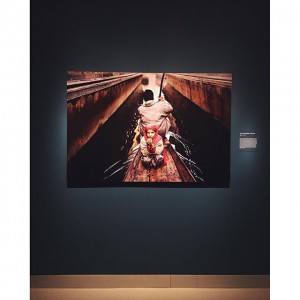The Steve McCurry’s India exhibit gave a side car to the viewer for a tag along with McCurry on his journey through different parts of India; in which, he showed different people and different traditions and ways they were celebrated. Upon entering the exhibit, the first thing that will be notice is that the walls are a shade of blue oppose to the standard white and the lights are at a dimmed level while the picture had strong lights hitting them. There are above 20 photos which range from portraits to landscape type of layouts but was still able to maintain enough spacing for a group of people to gather in front of one picture at a time without blocking another photo. The photos which lays on the walls ranges from natural disasters to things seen while transporting to celebrations and cultural norms.
Even though the pictures had such different ranges, they did manage to keep the same emotion roughly though out; furthermore, from the way he caught people in such natural environment to the way these people gave such genuine and non forced expressions. McCurry did not save face when it came to showing India, he did not just show the good glamour look of India such as a wide focus shot of the Taj Mahal. The photographer showed the rough times faced and the happy times celebrated, but it does not matter which of the two being showed the elements of comradely is still portrayed strongly. From the way these people group together to protect each other in an unexpected disaster or in Holi to hold each other up; as a result, his photos lack that pitiful look which images that include destruction normally provoke and instead welcomes hope and happiness with smiling faces.
In the exhibition’s collection there were plenty of works that caught my attention from the “Dog Balances on the Only Remaining High Ground in Monsoon Flood” to the “Crowds Gather for he Kumbh Mela Festival on Temporary Pontoon Bridges across the River Ganges”, but the one that really took my attention and kept it was “Father and Daughter on Dal Lake”. This piece in particular shows the trial and relationship between a parent and a child; also, I find it interesting that it kind of lacks a smile like his other photos but that did not deprive the picture of hope, given that their route to their destination is not conventional but yet they still persevere on a daily. Then what strengthens this photo even more is the strong diagonals giving a flow and movement to the photo; in addition, there is color, the red stands out from the grey and the brown so viewers’ eyes will always be drawn back to her face in which the real emotion of the photo is. Then there is the high angle in which this was shot and the strong front light given that there are no shadows and also that the subject is looking directly at the camera, giving a strong interaction between subject photographer and viewer.
McCurry’s most Famous photo is that of the “Afghan Girl” which made the cover of National Geographic. The strength of the photo lays in the color relation and composition, because it also closely gives the feel of another widely known piece, “jan vermeer girl with the pearl earring” due to the pose and it has been compared to the Mona Lisa being called the “First World’s Third World Mona Lisa“. The use of diffused lighting gave strength to her green eyes, which I must say was the first thing I notice when seeing this photo, The beauty and captivation of her stare draws you in, and it also correspond with the green of her shirt and of that of the background; then there is the strong red which kept your attention to her face and separate her from the background. The story is about Sharbat Gula, also known as Sharbat Bibi, an Afghan woman who was living as a refugee in Pakistan during the time of the Soviet occupation of Afghanistan when she was photographed by McCurry. McCurry was enchanted by her eyes and knew he wanted her as his photographic subject, he seen an element in her that would strengthen his piece; therefore, the strength and innocence of her stare showed him the pride and self-respect females had even in those times of hardship which gave him inspiration. This exhibition in all thought me that photography can save lives, inspire and introduce people from other parts of the world to get involved and improve a life, while seeing the beauty which hides in hardship.





You describe the exhibit and the Afghan Girl photo clearly and well. I think the question of what kind of place is Steve mcCurry’s India a very interesting one. Photographers have a lot of power to influence their audience. While he can be accused of romanticizing India and not showing the contemporary side, he also doesn’t just show the touristy highlights. He captures everyday people with a lot of dignity and shows a great respect for the culture of India. I like what you wrote about this, finding “the beauty in hardship.” And I would add the strength.